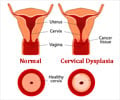Data from a large, retrospective cohort study published in the May 12 online issue of the Journal of the National Cancer Institute has found that the long-term risks of invasive cancer and recurrence of severe cervical intraepithelial neoplasia (CIN) are higher among women previously treated for CIN, when compared with those with no CIN diagnosis.
The study was undertaken because information on the long-term risks of subsequent CIN or invasive cancer among women previously treated for the disease is limited. More information on long-term risks is needed to help guide long-term follow-up of these patients.To determine such risks, Joy Melnikow, M.D., of the Center for Healthcare Policy and Research at the University of California, Davis, and colleagues retrospectively identified a CIN cohort of 37,142 women who were treated for CIN 1, 2, or 3 from January 1, 1986, through December 31, 2000, and compared them with a cohort of 71,213 women with no previous CIN diagnosis. Both groups were under active surveillance through 2004.
The researchers found that risk for subsequent CIN or cervical cancer was associated with initial CIN grade, treatment type, and age. The risk of invasive cervical cancer and CIN 2/3 recurrence was highest for women who were older than 40 years, previously treated for CIN 3, or treated with cryotherapy. According to the study, the highest rates of CIN recurrence were observed in the first 6 years after treatment in the CIN cohort, with a majority of those identified in the first 2 years. Recurrence rates for CIN 2 or 3 during this 6 year period ranged from 2.3 % in the lowest risk group to 35% in the highest risk group. Overall incidence of cervical cancer in the CIN group was 37 cervical cancers per 100,000 woman-years compared with six cervical cancers per 100,000 woman-years among women who had not been previously diagnosed.
"This large, population-based cohort study with more than 300,000 women-years of observation in the CIN cohort provided important information that could contribute to evidence-based guidelines for follow-up of women treated for CIN," the authors write. "Future randomized trials will need longer term follow-up to define the impact of treatment choice on subsequent CIN and invasive cancer."
In an accompanying editorial, Edward J. Wilkinson, M.D., of the University of Florida College of Medicine in Gainesville, Fla., points out that these results support evidence that active surveillance has value in identifying most incidences of CIN 2/3 recurrence and early stages of cervical cancer. He also notes that the majority of women who were later diagnosed with CIN had their CIN 2/3 diagnosed a relatively short time later (2 years). This short interval suggests that the subsequent CIN lesion was probably persistent CIN 2/3 rather than a new lesion.
"[T]his work provides evidence that women with CIN who have undergone treatment need long-term surveillance after their therapy and remain at some risk for CIN as well as for cervical carcinoma for 20 years or more," he concludes.
Advertisement
TAN/M















